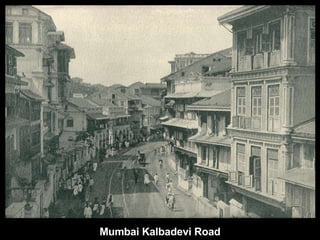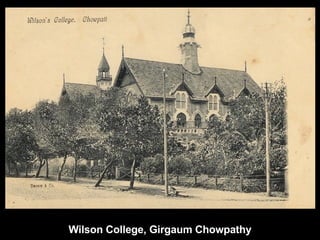Theatre, and other Amusements.
During the cold seasons of these eventful years (1810-20),
the theatre was in evidence, the actors being all amateurs.
Many of the play-bills lie before us. Some of the pieces, were—The Road to Ruin, The Heir-at-Laio, Old Mother Goose,
and The Wheel of Fortune; and on one occasion, we observe,
the whole is to conclude with a recitation of the celebrated
poem of Glenjinlas, a piece which, at the moment, we cannot
recall to memory. All these fancies were bodied forth in the
old theatre ; but in 1818, after our great successes in EurojHj.
21 GLIMPSES OF OLD BOMBAY AND WESTERN INDIA.
and the Dekhan, a brand-new theatre was constructed : " Doors
open at 4, performances to begin at 7 precisely. Tickets for
box*and pit, Rs. 8
"
; and we observe (1811) no tickets were to
be issued for the gallery. Doubtless a select audience, and the
proceeds for some charitable object.
Gentlemen, unless actors, were on no account to enter the
green-room, or go behind the scenes, and all gentlemen without
ladies were earnestly entreated to make their way to the pit,
leaving the boxes to the ladies and the gentlemen who escorted
them.
1820-40.—In August, 1828, we read : " The Bombay Theatre
is now a desert "
; and the writer attributes its decay to " the
march of morality, the want of money, the growing love of
early hours, fashion, and the progress of fastidiousness."
July 11th, 1829.—
"The Bombay Theatre is now consigned
to such ignoble purposes as the reception of Gogo cotton and
gunny bags ; once fertile in good performers, as in the age.
of the Brooks, the Bellasis, the Stanleys, and the Bells."
1831.—Arrangements to open the Bombay Theatre, which
has been long suspended. March 13th, 1834.—Theatre half
filled. " We may now sing a requiem over the drama in this
Presidency." July, 1835. —Bombay Theatre offered for sale., " After Mr. Newnham left last year there was no hope for it." John Peter Grant was also a steady supporter of the drama,
both in Bombay and Calcutta. October, 1835.—Theatre sold
to Jamsetjee Jejeebhoy for Es. 50,000. 1837.—
" Theatrical
displays are scarce worth attending." July 24th, 1840.—A
petition, signed by 425 inhabitants, for a new theatre in
Bombay. These notices sufficiently disclose the state of the
theatre in Bombay, and its decadence for a dozen years.
From some observations we gather that the Native Theatre
was not extinct, and what was called the " Legitimate
Hindoo Drama" in Poena, in Sir Philip Woodhouse's time
(1872-7), flourished unabashed in its travesties of the English,
until it was suspended by authority. The following refers to something similar, satirising our noble selves. The time is 1830-40 ; scene, the Mofussil Court House. We merely give a petit morceau before the curtain fell. As the case proceeds,
and the tiuie approaches for the midday meal, the butler comes
BOMBAY DOMESTIC ANNALS, 1810-1893. 25
in and announces to the Judge, "Tiffin tyar hi." This, of course,
he does with joined hands and obsequious deportment. The
Judge immediately stops the case, and is proceeding to leave
the Court-room, when he is accosted by the officers of the.
Court with,
" Pray, your lordship, what shall we do with the
prisoner ? " Judcc exit, with " D—n his eyes, hang him ! "
Bombay and Poona (1820-30) were not without other
amusements. In connection with the revival of cricket in
1825, we read : —
" There will be tents for the ladies, and as the cricketers are all to be dressed in an appropriate uniform, we anticipate one of the most gay and animated scenes that has ever graced our island.
" We feel infinite pleasure in announcing amusements
which tend to counteract the effects of this enervating climate,
by raising the spirits from apathy, and the physical powers
from that feminine indolence which is generally rewarded by
premature old age, skin hanging in drapery, and muscles
reduced to pack thread."
This same year, on October 28th, there was a very big dance
in Poona in honour of Sir Charles Colville, Commander of the
Forces, and 200 were present on the eve of his departure.
There was a suite of tents, and his great battles were blazoned
in letters of light—San Domingo, Martinique, Egypt, Badajos,
Salamanca, Vittoria, Nive Nivelle, Waterloo. There were
country dances, quadrilles, succeeded by waltzes and Spanish
dances till 12. Then followed supper ; then they danced till dawn, when the morning gun was the signal for departure.
Eaces.
The Bombay Races and Hunt were in this decade (1810 to 1820) in the full flush of prosperity. They took place in
February ; began with daylight, and ended in a big breakfast,
which, most probably, before it was ended, annexed itself to a
tiffin. The races of 1819 are a fair sample. Mr. Remington's
Cup was presented tj the victor by Lady Grant Keir. The
2()
GL1MP8ES OF OLD BOMBAY AND WESTERN INDIA,
Forbes Stakes, £100—which are still (1892) run for—were won
by ]V^, Warden's Arab horse Dapoorie, beating Guzerat and
Hotspur. The Ladies' Purse, Es. 400, with five gold mohurs
each, was run for by Clan Alpine, Speculation, and Greybeard.
4th day.—The Malet Stakes.
5th dav.—The Batchelors' Purse, Es. 400, with five sold
mohurs each.
6th day.—The Gold Turf Cup, value 100 guineas, given by
the Tuif Club in 1802, and now in possession of Mr. De Vitre.
In 1816, for the purpose of attracting the fair sex, the
Bombay Eaces were held no longer in the morning, but in the
afternoon, a custom from which there has been, we believe, no
departure.
The period of 1820-30 was an era of decline for both hunt
and races. On February 1st, 1828, it is noted : " Bombay Eaces
are not remarkable enough to be recorded." The following
wail had appeared in the Bomlay Gazette in 1827 : —
" 'Twas in the olden time our Bombay Eaces Commenced at daylight, spite of fog and dew.
* »
• * * The ' Bobbery Hurt's Delight' or 'Garry Owen'
AVas sure to set the nimble ftet agoii.g. All's over—early rising—breakfast—all;
Yet what mementos do the names recall Of spirits —blotted from the things that be,
Gone like the ' Bobbery Hunt ' and * Sans Soiici,' For though the Bobbery, when in search of game,
Were terrors to old crones and yelping pyes, Convivial friendship will preserve their name As those who bade the brightest fires arise. And but once more to hear their bugle strain Bombay might rouse thee to be g ly again."
This spirited piece was headed " Lost Gaiety of Bombay."
In 1815 Poona seemed more vigorous, and received from
England eight couple of hounds in the highest condition, with
four couple of whelps produced on the voyage. Calcutta, up
to 1840, held their races in the morning. The hunt there also
involved a start at 4 a.m., and for this reason seldom more than
fifteen gentlemen responded ; and the ladies, at both hunt and
races, were very----------------


































